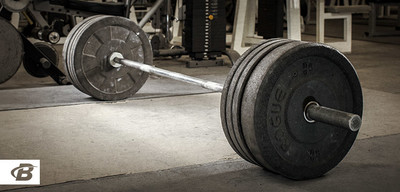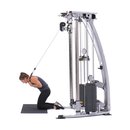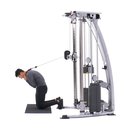Let's face facts: Training abs kind of sucks. You're not going to set any personal lifting records on a Roman chair, and the only way you could possibly get a pump in your midsection is if you accidentally scoop Ajax into your shake instead of creatine.
No one feels butterflies of anticipation in the moments leading up to an ab workout, and unless they call you "The Situation," you're probably not going to be admiring your abs in the gym mirror.
Still, there's no getting around it: You have to train your abdominal region, for reasons both of form and function. A set of "washboard" abs ties together a physique in a way no other body part can, and having a strong core is a surefire safeguard against myriad physical ailments. Think of it as bi-winning!
So, if you're going to be training your abs (and you are) then you might as well make the process as bearable as possible. With a little help (see below) you can even make ab training enjoyable.

If "this sucks, this sucks, jesus, this sucks," is what goes through your head during an ab workout, then you came to the right place.
Mix It Up
One of the "secrets" to getting great abs is frequency. The abdominal muscles are notoriously dense, and like forearms and calves, can withstand regular punishment. They just recuperate faster than your biceps or quads can.
Ideally then, you'll want to hit your ab muscles no fewer than three times and as many as six times per week. That sounds like a lot of training; a lot of long, tedious, boring training, doesn't it?
No doubt you're already envisioning six days per week performing hundreds of reps of crunches and leg raises.
The truth is, ab training doesn't have to be all that repetitive, and it doesn't have to be that long or even too boring. I've found that you can do long workouts, or you can do frequent workouts, but you can't do long workouts frequently.
Since few have the patience to spend 20-to-30 minutes at a time on abs, a more reasonable option is to train them for shorter periods at more frequent intervals.
Hitting abs 3-to-6 days per week demands variety for reasons both physical and mental. From a physical standpoint, targeting different areas of the midsection on consecutive days allows for maximum recuperation of the areas not being targeted.
The mental benefit is obvious: You're not going to grow tired of the routine, and the more your mind is in the game when you're training, the more your body benefits.

One hundred twenty-one, one hundred twenty-two, one hundred twenty ... Ah crap i lost count!
6 Step Program
You don't have to train your abs every single day, but six times per week wouldn't hurt. If you can't stomach the idea of working your midsection that often though, 3-to-4 days will suffice.
However many days you decide to train your abs though, you should alternate between A, B and C categories in sequence. Just keep cycling through the three categories, regardless of which of the two workouts in each you decide to use.
The three categories, aka A, B and C, each focus on a different section of your midsection. A primarily targets the upper abs. B stresses the lowers. C concentrates on the sides, the obliques and intercostals.
The idea behind this training system is to blast each of these areas on a separate day, giving the other parts of your midsection a little recuperation time.
Of course, you can't entirely isolate areas of such a large, cohesive group of muscles, but the abs do recuperate more quickly than most other muscle groups. So they can handle some overlapping work.
You can train your abs at any time of the day and in any relation to the rest of your training, but I've always found that ab work makes for a nice transition out of a workout.
The eight minutes or so it takes to complete each of these six routines provides the perfect time to let your mind switch off from the punctuated stresses of trying to move heavy weights to the more deliberate and meditative qualities of 25-rep sets.

Whenever you choose to train your abs though, keep it brief. Aim for just 15 seconds of rest time between sets and move directly from the first exercise to the second, without stopping for water or to catch up with a buddy en route. The workouts should take you no more than 6-or-7 minutes at most.
If you can get them done in 5 minutes, all the better. So long as you're not sacrificing form for the sake of speed, the faster the better.
Ready for the workouts? Good. Rock 'n' roll!
Core Muscles
Rectus Abdonminus

- Also known as the "6-pack," this is one are of the body which, if well developed, will turn eyes your way; but if underdeveloped and covered in adipose tissue, will cause uncomfortable squinting.
- The rectus abdominus runs from sternum to pelvis and is responsible for pulling your knees to your torso and rolling your torso forward and down.
- When we talk about "upper abs" and "lower abs," we're really talking about the rectus abdominus -- just the upper and lower parts of it.
Obliques

- The obliques are slabs of muscle that run diagonally down the sides of your body, between your rectus abdominus and lats.
- The function of the external obliques is to twist the body from side to side and extend and contract the torso laterally.
- Obliques play a large role in stabilization of the body during athletic events.
- There are both internal and external obliques.
Intercostals

- These run diagonally across your ribcage - below your pecs and above your external obliques, interlacing with the serratus muscles.
- The intercostals assist in deep respiration and coupled with the internal obliques work to expand and contract the ribcage.
- There are both internal and external intercostals.
Serratus

- These are the fingerlike muscles you find running from your lats to the sides of your ribcage and are interwoven with the external intercostals.
- The main function of the serratus is to extend the shoulders as far forward as possible.
- Contrary to popular belief, you can't train the serratus with crunches. Instead you'd do better to lie back on a bench with a barbell extended as at the top of a bench press and then pushing the bar even higher from the standard top position, lifting your scapula off the bench as much as possible.























